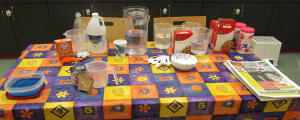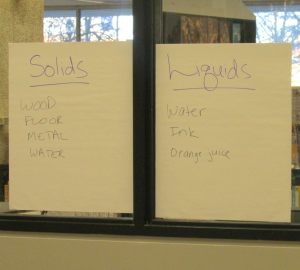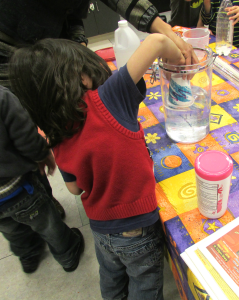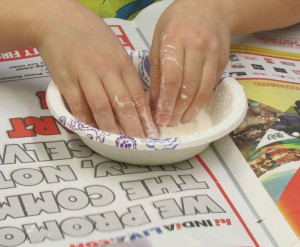When you put the time into creating a dynamic STEM (science, technology, engineering, and math) program for youth, it feels like a big bonus to be able to offer modified versions of the program to multiple ages of children. Below is a great example of a program that can be adapted for multiple age groups–and it’s recently field tested, having been facilitated here at Skokie Public Library for both preschoolers (ages 3-5) and kindergarten-2nd grade.
Our goal for early childhood STEM programming–which we typically offer under the program titles “Science Club Jr.” (for preschoolers) and “Science Club” (for early elementary)–is to twofold: 1) to equip youth participants to understand foundational science concepts at a very basic level; and 2) to allow the youth to use STEM terminology effectively and accurately. We’ve found most success in meeting these goals by developing programs in which participants can relate to their immediate environment as much as possible, preferably through demonstrations and hands-on activities.
Here’s what I did for a recent set of programs exploring the states of matter.
For the K-2 audience, I started the program by defining matter and the three states of matter: solid, liquid, and gas. Many kids will come to a program with some general concept knowledge, so ask participants for input before giving the definitions. So long as what the child contributes is moderately accurate, try to use as much of the child’s input as you can in the actual definition. I find it useful to have large sticky notes visible in the programming area and to ask for examples of each state of matter–this is a way in which every child can contribute. Talk about water and how it changes states. Having visuals here is a bonus, whether they are the real things or photographs from non-fiction books from your collection.
When offering this program to a preschool audience, start with a similar opening. Use a book like My World of Science: Solids, Liquids, Gases by Angela Royston (Heinemann Library, 2003) or the States of Matter three book series by Jennifer Boothroyd (Lerner, 2007) to talk about states of matter, then turn to examples in the program room around them. Ask what type of matter a chair or table is (solid), and have kids breathe on their hands to feel gas–or even wave their arms to see if they can feel their solid arms moving through the air (gas). Before moving on, be sure to reiterate that matter is everywhere, and that we are matter, too.
For both groups, begin with a few demonstrations to reinforce concepts of different states of matter and how these states may change.
Demo 1: Jello
- Shows the three states of matter. Talk through the process of making Jello and have participants contribute as you go.
- Boil water in electric kettle or use really hot water to see steam (gas).
- Show Jello crystals. Ask what state of matter it is (solid). Make sure everyone can see the crystals.
- Add to water. What happens? (A solid is mixed with a liquid. Stays liquid.)
- Ask what happens next in making Jello? (Place in fridge to remove heat.)
- What happens? (Turns to a solid.)
- Have final Jello product ready to show and feel but not eat!
Demo 2: Acid Base Balloons
- Use your favorite kitchen chemistry acid base reaction to create a gas that inflates a balloon. I used vinegar and baking soda since it was on hand.
- I wrote out the equation for the older kids and explained what happens in an acid base reaction (the reaction produces water and carbon dioxide).
- Use a plastic pop bottle and balloon. You can allow each child to do the demonstration, or have them conduct the experiment in pairs or groups.
- Pre-fill the bottles with baking soda or another solid (depending on what reaction you’re using). Consider having funnels or measuring cups for pouring your liquid into the bottle.
- Once you pour the liquid into the bottle, quickly affix the balloon around the top of the bottle.
- Have participants feel the balloon as it fills with gas. Reiterate that gases do not have defined shapes but can be contained in things like the balloon.
Demo 3: Napkin Test
- Place a napkin inside a plastic cup. Secure it with tape.
- Fill a large bowl with water.
- Tell participants you are going to place the cup inside the bowl with the napkin facing the water. Ask for predictions.
- Place the cup inside the bowl, straight down.
- Push the cup down to the bottom of the bowl.
- Remove the cup.
- Is the napkin wet or dry? Why? This demonstration offers a good opportunity to discuss gas/air since air gets trapped between the surface of the water and the inside of the cup. As you push down, you can feel pressure from the trapped air. Having participants take turns with this activity helps emphasize that gas/air takes up space inside the cup, preventing the water from getting the napkin wet.
Hands-On Experiment: Goop (Thixotropic Mixture):
- Find a clean surface (that can get dirty!). Covering tables with newspaper or butcher paper is a good idea.
- Have a bowl and spoon for each participant, if possible.
- Place a box of cornstarch with a spoon at each table or station.
- Instruct participants to add 2-3 spoonfuls of cornstarch into their bowls.
- Ask the children to observe whether the cornstarch is a solid, liquid, or gas.
- Then add water; either instruct participants to pour water or pour it yourself, just a little, into each bowl. Ask what state of matter water is.
- Mix cornstarch & water. Stir.
- Keep adding water until the mixture looks like cake batter. You’ve made “Goop”!
- Now try picking up the mixture, rolling it around and then dropping it back in the flat surface again.
- You will see that Goop will act as a solid under certain circumstances and as a liquid under others. It’s a thixotropic mixture!
At the end of the program, ask final questions about states of matter from the provided activities, encouraging participants to use their new vocabulary to describe what they learned. Take-homes can include an outline of the activities facilitated in the program, the Goop recipe to promote further experimentation at home, and a basic coloring sheet with the states of matter illustrated.
Depending on your library, this program can be further adapted to accommodate for pop-up programming, limited supplies, or greater participant numbers by selecting one demo and one hands-on activity. Give it a try and share your experience in the comments!








Leave A Comment